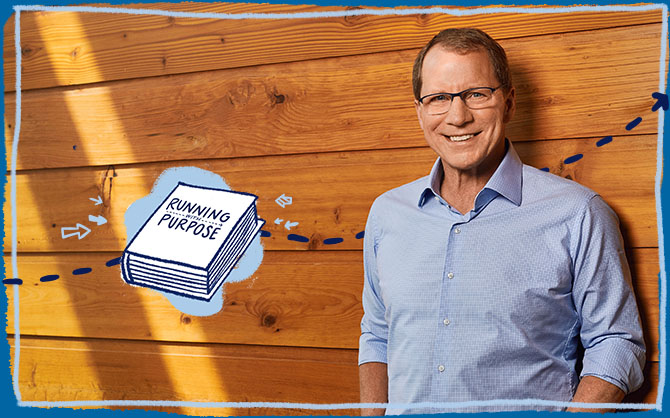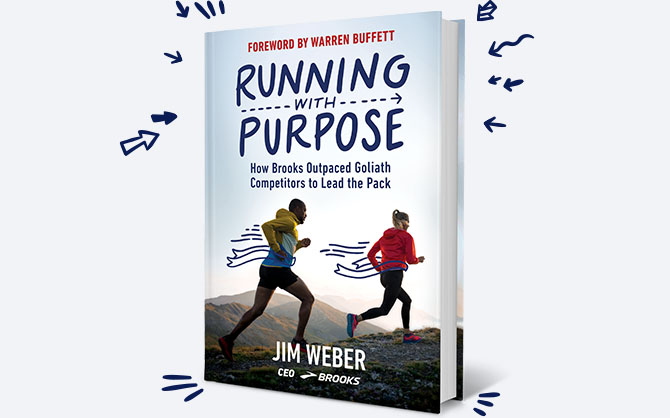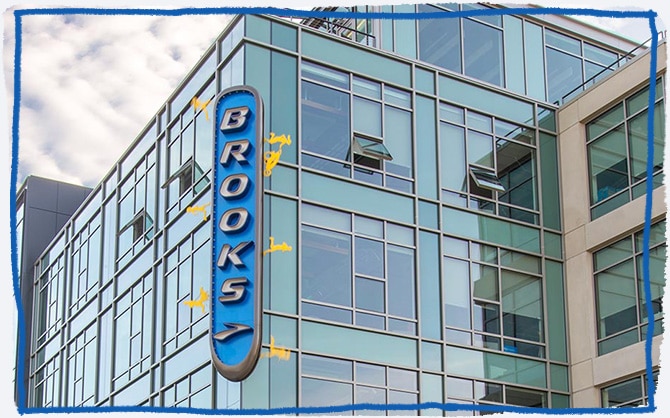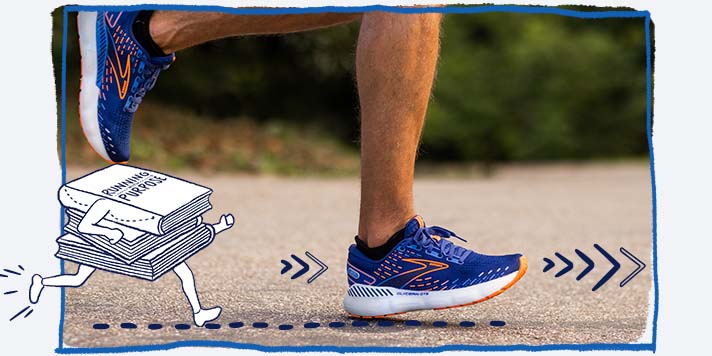Ready, set, read the inspiring story of our brand.

CEO Jim Weber's new book celebrates Brooks’ inspiring purpose and why we believe a run can change a day, a life, the world.
At Brooks, we’ve built up decades of knowledge about the run, but it’s the wisdom to listen to the runner that fuels our story. The runner is at the center of everything we do. In Running with Purpose, a new book from CEO Jim Weber, readers will explore how that philosophy helped Brooks go from near bankruptcy to the front of the pack in the global performance running industry. Full of insights and stories, Running with Purpose is an inspiration to leaders, entrepreneurs, brand builders, and the 150+ million runners worldwide.
Brooks sat down with Jim to ask about the book and his journey. Check out his responses below.

Brooks: After more than twenty years serving as CEO of Brooks, what prompted you to write a book?
Jim Weber: The push I needed to commit, sit down, and write a book came from Berkshire Hathaway Chairman and CEO Warren Buffett. In late February 2020, just one month before the Covid-19 lockdowns, I was flying west to Omaha from Atlanta where Brooks had just cheered on our nation’s best marathoners at the U.S. Olympic Trials. I was energized and inspired after watching these athletes compete for a spot on Team USA for the upcoming Tokyo Games. Warren had invited me to Omaha for a Sunday morning breakfast meeting as I had recently started a dialogue with him to get his perspective over seventy years in business on the broad-based erosion of trust in business, institutions, and leaders. Warren and I dove into a lively discussion on my leadership trust topic, the economy, and all things Brooks. As we closed out our morning conversation he added, “Jim, Brooks is a great story. You should write a book.” The truth was I’d been thinking of doing so for years. I believed to my core that the Brooks story as a business and challenger brand deserved to be shared — especially with runners — so my conversation with Warren was just the nudge I needed.
Brooks: When you took over the helm at Brooks, the brand had a ninety-year playbook to build shoes and apparel for various sports from baseball, football, and basketball to tennis, cross training, and running. Why did you decide to focus solely on performance running?
Jim Weber: Back then, Brooks and all the athletic brands were competing for sales to the masses, trying to cover every sport and every price point with visible technology that had eye appeal on the shelf. Brooks was sixth or seventh in every category — few people would have missed the brand if it disappeared from the retail wall. Meanwhile, road race participation had increased 25 percent over the previous five years. Running was exploding, but very few brands (including Brooks) appeared to notice. Performance running was a backwater. I felt that if we focused there and earned a small piece of it, we could not only survive but build a meaningful brand and a valuable business.
Brooks: Are you a runner? If so, what role has running played in your life?
Jim Weber: Growing up in Minnesota, my first love was hockey. I went all in, playing competitively into college, and had NHL dreams. But when the reality of my natural talent set in around age 20, I needed to find a new activity that allowed me to exert myself, get my heart rate up, and fill my innate desire to move. It was 1980, and at the time, the “jogging boom” was underway, so, I gave it a go. In 1982, I pinned a bib to my chest and completed the inaugural Twin Cities Marathon in 3:31. Though I hit the proverbial wall at 32K, the experience stoked my young love affair with running.

I needed to run like I needed air and water. I fit in a run whenever my work and family schedule allowed — morning, noon, or even late at night once the kids were in bed. Sometimes after dinner when the boys were young, we would grab the dog and head out on what we called bike-runs — the boys pedaling alongside the dog and me as we ran through our neighborhood streets. When alone, running has always been good mental processing time. Kilometer after kilometer, I processed my biggest questions or challenges at work and in life. On many of my birthdays, I put together a music mix — often anchored with deep tracks from Bob Dylan — and treated myself to a 10K Zen run. Running for me is a gift.
Brooks: When you got to Brooks in 2001, you were the fourth CEO in two years. There is a rumor that a staff betting pool said you would last four months. What was your secret to leading the company where others had failed?
Jim Weber: When I joined Brooks, I put this quote on my whiteboard and it has been there for over twenty years: “The secret to success is constancy of purpose.” My initial intent was to keep MYSELF focused, but then I realized that a shared purpose could catalyze everyone on the team around a singular and clear reason for being. In search of a North Star for Brooks, we settled on creating a purpose that we could measure from the outside in. We committed to: Inspire Everyone to Run their Path. The word “inspire” was key. To deliver on that calling, we knew we would be challenged every day to engage authentically with the minds AND hearts of runners. There is no silver bullet for success, but leading with purpose has been key for me and a true advantage for Brooks in our crazy competitive global market.

Brooks: You said the first treadmill Brooks purchased to collect runner biomechanics data was tucked into the copy-machine room, and then not long thereafter, “[Brooks] got serious about biomechanical research.” What did it take for your team to map their way from a corner treadmill to an in-house, state-of-the-art biomechanics lab?
Jim Weber: If we were to be successful at building performance gear that people trusted kilometer after kilometer, we needed to create more hands-on learning across the product team. We decided to invest aggressively in research and development of the mechanics of human motion, running, and injury. We then committed to build our product on the foundation of the latest biomechanical research, technology, and analytics. As we grew our onsite lab, we partnered with two world-class university research programs and funded clinical studies. We brought on leading researchers to study every runner’s “run signature,” which is an individual’s unique running form defined by their body’s own habitual motion path. This research gave us the confidence to pivot away from the conventional industry belief that shoes should “fix” the way a runner runs. Our job is to make your running shoe, not someone else’s. We make the shoe that helps keep you on your path.
Brooks: What is your favorite product that Brooks has created in the last twenty years?
Jim Weber: I can’t pick just one! Brooks has a long and recognized history of product and materials innovations that predates my time with the company. And since I joined, there have been many more. Technologies like the Progressive Diagonal Rollbar and Guiderails; materials like BioMoGo, DNA AMP, and DNA LOFT; styles like the Adrenaline, Ghost, and Green Silence; and collections like PureProject and Run Visible have been groundbreaking not just for Brooks but for the industry. Each one has pushed the boundaries on what great running product can deliver in terms of fit, feel, ride, and function. They’ve each earned high credit from the industry and from runners. Even better, innovations like these give us great learnings we apply to future product development.
As for what’s in my personal gym bag today, I’ll sport anything our product teams ask me to test! But when given the choice, I always grab the Glycerin GTS. It has an incredibly cushioned ride with just the amount of support I need for the way I run.

Brooks: You’ve achieved and celebrated an impressive list of milestones in the last twenty years. What milestone was personally most satisfying?
Jim Weber: I believe to my core that life is about the journey. For me, it’s not about the finish line. It’s about the satisfaction that comes from all that it took to reach the finish line. I have found that once you get a win, the satisfaction of it, in and of itself, is fleeting. So it’s important to mark the milestones along the way, and we’ve celebrated many at Brooks as each one validates our purpose-driven brand and business strategy. I’m proud of each one but am even more proud to be part of the committed team at Brooks who has executed for the runner so well and consistently, day in and day out.
And then there are the more personal milestones. In 2017 I was diagnosed with esophageal cancer, which has a 20 percent five-year survival rate. Today, nearly five years out from my diagnosis, I believe the cancer is gone. I wake up every morning with no thought or fear of it. Joining the cancer club was of course anything but satisfying, but I now know every day I have is a gift and my task is to soak in the moments each one presents. Joy, happiness, and meaning are not waiting at the finish line of life but come from the journey you are on with your family, teammates, friends, and people you meet along the way.
Learn more about Brooks, our love for the runner, and Jim Weber’s new book: